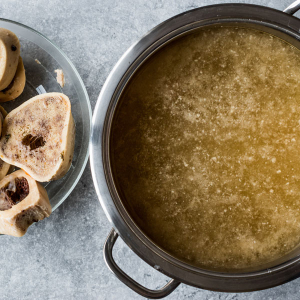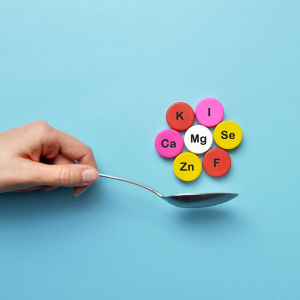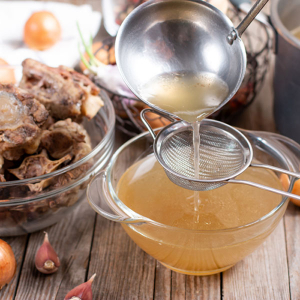Bone broth
– what is it good for and how do you make it? –
– Written by Ingrid Smolders and Isabel Koutzarov –
Resume
Bone broth is made at a low temperature from cartilaginous bones, such as chicken carcasses or even better, chicken feet or duck feet. The result is a broth with many positive health effects, such as extra vitamins and minerals, you add collagen (type II) which has enormous effects on the coat, skin, nails and the immune system also gets a boost.
It's fantastic for bad eaters and/or recovering animals and for cats it's an ideal way to get them to drink more. Do you want to know more? Or do you want the recipe to make it yourself? Then read below!
What? Soup for my dog/cat? Why?
Well, for example, because of the many positive health effects of bone broth, such as:
- It contains a lot of vitamins and minerals
- It contains collagen
- It contains gelatin
- It contains glucosamine
- It contains, among other things, the amino acids glycine and proline
- Dogs love it, it provides strength after illness , supports the health of old and (chronically) ill animals ,
- ideal way to get the animal to consume more fluid
In short, the possibilities are enormous!!
First of all; what is bone broth?
Is that from one of those blocks?
No, you know that Big Dog Company is not into packages and blocks, right? Fresh and pure, that's what we want!
Bone broth is the soup that your grandmother made, or your great-grandmother, and that many traditional peoples still make.
So not the stock that we usually buy/make nowadays: made from meat. That is a lot easier than pulling stock from (cartilage) bones, but also a lot less nutritious and less tasty. This is often compensated for with chemically manufactured flavor enhancers such as MSG, which are notorious for their questionable health effects.
Why Bone Broth?
What is bone broth good for?
Precisely because of the long production process at a relatively low temperature and using (cartilage) bones, this broth contains countless healthy substances.
Our (and the dog's/cat's) connective tissues are particularly grateful for a portion of bone broth: barriers such as intestines and the skin, bones and joints, coat and nails.
For intestinal health, bone broth is a true superfood , because it helps heal the mucus layer in the intestines, something that many dogs can use!
In addition, it strengthens the immune system and it has been scientifically proven that bone broth is one of the most effective ways to fight viral infections. And dogs also suffer from circulating viruses from time to time.
The benefits of Bone Broth at a glance:
- Vitamins and minerals: bone broth contains many minerals such as Calcium, Magnesium, Phosphorus, Sulfur, in the right proportions. Easily absorbed by the body and good for healthy bones, teeth, nails and coat. It also contains vitamins A, K, C and minerals Iron and Zinc, which are essential for healthy bones
- Collagen: This is a glue-forming protein found in the bones of vertebrates and is the major structural protein in connective tissue. There are different types of collagen, of which type II is most common in joints. Found in bone broth, this type of collagen supports joint health and can even help heal inflammation in joints. It even works better and faster than glucosamine/chondroitin for osteoarthritis!
- Gelatin: the prolonged pulling of the bones breaks down the collagen into gelatin. That is why the stock, when cooled, has such a jelly-like texture. And it is precisely that jelly that helps protect and soften the intestinal wall and also helps heal any damage. Think of all dogs with possible nutritional intolerances or parasitic infections, where there is a high risk of a damaged intestinal wall.
- Glucosamine: Bone broth is rich in glycosaminoglycans (GAG), long chains of carbohydrates found in bones and tendons that can help reduce joint pain. The best known GAG is glucosamine. Another GAG that occurs in bones is chondroitin sulfate and exercise is believed to be effective in osteoarthritis/rheumatoid arthritis.
- Amino acids Glycine and Proline: the amino acid glycine directly supports digestion by increasing stomach acid production. This is positive, dogs (just like people) often have too little acid instead of too much acid. Glycine is also an important component of bile acids, which are a very important part of fat digestion in the small intestine. In addition, glycine is anti-inflammatory, helps heal joint inflammation, helps improve sleep and brain functions. The amino acid proline is essential for the formation of cartilage. The above are not essential amino acids (so the body can produce them itself), but only in optimal health.
And finally,
the recipe for Bone Broth!
How do you make bone broth?
What do you need for approximately 2 liters of bone broth:
- 1 kg Cartilage-containing bones and/or marrow-containing bones. On our website we have various (organic) bones, for example duck back pieces , chicken back pieces , or: duck walking feet
- Option: number of marrow bones. This adds flavor and bone marrow contains specific nutrients that are very nutritious. Then DO NOT give the marrowbone to your dog! Risk of blockage, wearing down of teeth, stuck around lower jaw
- Dash of apple cider vinegar
- A soup pot
- Option: raw vegetables
And then, how do you make bone broth?
- Place the bones in the stockpot.
- Fill the pan, just as you would make a stock, about 4cm above the bones
- Add a dash of (apple) vinegar, this helps to extract the minerals from the bone
- Bring it just to the boil, stir if necessary. foam off
- Then let it steep/simmer for at least 3-4 hours. So DO NOT cook !
- Reduce it slightly at the end (so turn it up a bit, but carefully)
- Let it cool until you can sift the bones out, cool them and place them in containers, for example. You can also put some of it in containers (for smaller dogs) and some of it in ice cubes. When the cubes are gone, you can defrost a container and freeze it again in ice cubes.
Extra Tip : Read our blog(s) about the health of vegetables for dogs and add vegetables to your stock at the end. You can also read how to prepare vegetables and how many vegetables you can give to your dog .
Finally
Are you thinking, yes, that's nice, but I don't have the time/patience/talent to cut a tomato yet! No worries; Fortunately, we are blessed with an inexhaustible urge to cook! We regularly have a pan on the stove with delicious bone broth.





